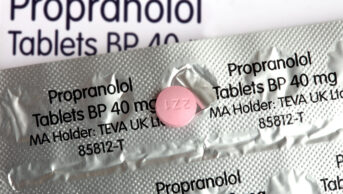
Contraband Collection / Alamy
There have recently been a number of deaths from users who ingested the ‘Superman’ pill, which contained a toxic substance, p-methoxymethylamphetamine (PMMA). We can assume that the users did not know what was in the pills before they ingested them, although they probably thought they were taking 3,4-methylenedioxy-methamphetamine (MDMA), a popular recreational drug widely known as ‘ecstasy’.
Providing a service where users can have their drugs tested before they take them is one way to help reduce hospital admissions and deaths.
What’s in the tablet?
Every year in England and Wales around half-a-million people[1]
aged 16 to 59 years take ecstasy, and every year there are 30 to 40 fatalities where MDMA is mentioned on the death certificate[2]
. Despite the plethora of new psychoactive substances[3]
, nearly all of which occur as loose powders, most tablets sold as ecstasy contain MDMA. They may also contain other substances, but few are of serious toxicological concern. Two principal exceptions to this rule, however, are p-methoxy-amphetamine (PMA) and PMMA. Accurate information on the number of PMA and PMMA tablets in circulation at any one time is difficult to estimate; police seizures submitted for laboratory analysis in the past two years suggest they represent less than 5% of all ecstasy tablets. Both are associated with a disproportionate number of deaths. For example, in 2012 there were 20 deaths where PMA or PMMA was mentioned on the death certificate, and in 2013 there were 29 such deaths[2]
. In other words, the intrinsic toxicity of these two substances is far higher than that of MDMA.
The latest outbreak of fatal poisonings associated with PMMA started in late 2014 and was not restricted to the UK. Media reports[4]
claimed that the deaths were connected with pink tablets bearing a Superman logo. A different Superman tablet, containing PMA, had been reported[5]
in Scotland in early 2014.
By late December 2014, the European Monitoring Centre for Drugs and Drugs Addiction (EMCDDA) reported that there had been six deaths in the UK and several non-fatal intoxications, and four deaths in Sweden[6]
. These fatalities are the latest in a long series of similar episodes spanning many years. The EMCDDA’s 2001 risk assessment pointed out that there had already been several deaths in Europe associated with PMMA. More recently, Vevelstad et al. reported[7]
on 12 fatal and 22 non-fatal cases in Norway in 2010–2011. In Israel, from 2007 to 2008, there were 24 deaths[8]
. It seems that deaths will continue to occur as long as drug users do not know what they are consuming.
Testing drugs in Europe
The concept of drug testing in this context is focused on public health and should be distinguished from those forensic science and related laboratories that carry out drug analyses on behalf of law enforcement agencies.
In some countries, the problems caused by particularly toxic substances were recognised at an early stage, and procedures were put in place to protect the public. In the Netherlands, the officially funded Drugs Information and Monitoring System (DIMS) was set up[9]
in 1992. It provides an analytical service for users whereby samples can be submitted anonymously at a DIMS centre and the results are made available online (http://www.drugs-test.nl/). The information disseminated includes physical details of the tablets (size, shape and colour) and the amount and type of psychoactive constituents.
Another officially supported system known as “Checkit!” has been in operation in Vienna, Austria, for many years[10]
. As well as identifying dangerous substances such as PMMA, it also helps to identify tablets (normally MDMA) that have unusually high drug content. Dangerous contaminants have occasionally been found in other illicit drugs, such as microscopic glass beads in cannabis, atropine in cocaine, and Anthrax spores in heroin.
Public Health Wales recently set up a drug-testing system known as WEDINOS[11]
. Like the Dutch and Austrian systems, information is collected from anonymously submitted samples, including tablets and powders, and analytical data are made available to the public (http://wedinos.org/). Also in the UK, a local system based at Manchester’s Warehouse Project[12]
is organised by Fiona Measham, professor of criminology at Durham University.
Would this work in the UK?
These projects seem to provide a valuable public service, but measuring their effectiveness is not easy. When poisoned patients present to hospital emergency departments, their blood and urine are rarely analysed. Perhaps the patient can recall the type of tablet consumed, but there is little reliable statistical information on drug morbidity. Information on fatal poisonings cannot be collected until post-mortem analysis has been completed and a coroner’s inquest has been held, a process that may take many months. Even then, conclusions can be confounded by the presence of other substances.
Six years ago, the Home Office Advisory Council on the Misuse of Drugs (ACMD) believed that a system similar to DIMS would be of value in the UK. Its recommendation (11.15) was part of the ACMD’s 2009 report[13]
on the classification of MDMA under the Misuse of Drugs Act. It read: “Consideration should be given to developing a national scheme for the purpose of testing MDMA with a view to providing harm reduction advice and developing monitoring data.” The government of the day did not accept the proposal.
The opportunity still exists to make a similar recommendation to the UK government. However, it is clear that a national drug-testing service would need to be supported by evidence that it would reduce harm, and that it would not be used as a quality control service for drug dealers, and it would also have to overcome the perception that it might condone the use of controlled drugs. But even in the absence of a UK-wide drug-testing service, there are still ways of making better use of the information we have.
Better dissemination of information
A European Union Council Decision in 2005 established a system for the information exchange, risk assessment and eventual EU-wide control of new psychoactive substances, a programme that is managed by the EMCDDA. The early warning system and information exchange components have proved particularly effective[14]
. Through this mechanism, the UK benefits from early notifications from other member states, with many of the alerts about dangerous drugs originating from DIMS in the Netherlands.
However, by the time the EMCDDA had issued an alert on 20 December 2014 concerning PMMA and the ‘Superman’ tablets[6]
, some of the damage to UK drug users had already been done. It’s not simply that the EU system is tardy, but the UK has probably the largest drug market in Europe, so new trends often happen here first. Furthermore, alerts issued by the EMCDDA are considered to contain sensitive information, and recipients are requested to show caution in distributing them further. So relying on our EU partners for information is only part of the solution and is a poor substitute for a UK-based drug-testing system.
If official support for a UK system is not forthcoming, there is still scope to do more with the information we have. For example, the EU drug alerts may well be useful to drug professionals and official agencies, but they are not in a format suitable for users.
If we are serious about reducing harm, then an improved mechanism is needed for disseminating information that targets drug users directly. It needs to have a simple message, be timely and be accurate. It must not condemn drug users nor refer to the legal consequences, and the mechanism must not be over-used. Although television and newspapers carry stories about drug problems, they cannot always be relied on to be accurate. I would suggest that public-service advertisements could be placed in the media and that they should be composed by those with direct knowledge, which has not always been the case with some official ‘anti-drug’ messages in the past. Perhaps the best agency to mount such an advertising campaign is the UK Focal Point on Drugs, located within the Department of Health.
Punitive measures will not prevent drug-related deaths and hospital admissions. But testing drugs and informing users really could prevent unnecessary deaths and minimise harm. After all, if users know they have a tablet that contains a toxic substance, they are unlikely to ingest it.
Leslie A. King was an analytical chemist in the pharmaceutical industry for eight years and a member of the Forensic Science Service for nearly 30 years, the last 10 as head of drugs intelligence. He is also a former member of the Home Office Advisory Council on the Misuse of Drugs.
References
[1] Drug Misuse: Findings from the 2013/14 Crime Survey for England and Wales. Home Office (2014).
[2] Deaths Related to Drug Poisoning in England and Wales, 2013. Office for National Statistics (2014).
[3] Brandt SD, King LA & Evans-Brown M. The new drug phenomenon. Drug Testing and Analysis 2014; 6:587–597.
[4] ‘Superman’ ecstasy pills in Ipswich contain PMMA tests show. BBC News (2015).
[5] Alert over Superman ‘ecstasy’ tablets. BBC News (2014).
[6] The Dutch Drugs Information and Monitoring System (DIMS) has issued an alert regarding ecstasy tablets containing a deadly amount of para-methoxy-methamphetamine (PMMA). European Monitoring Centre for Drugs and Drug Addiction, 22 December 2014. (Restricted access.)
[7] Vevelstad M, Øiestad EL, Middelkoop G et al. The PMMA epidemic in Norway: Comparison of fatal and non-fatal intoxications. Forensic Science International 2012; 219:151–157.
[8] Lurie Y, Gopher, A, Lavon, O et al. Severe paramethoxymethamphetamine (PMMA) and paramethoxyamphetamine (PMA) outbreak in Israel. Clinical Toxicology 2012; 50:39–43.
[9] Brunt TM & Niesink RJM. The Drug Information and Monitoring System (DIMS) in the Netherlands: Implementation, results, and international comparison. Drug Testing and Analysis 2011; 3(9):621–634.
[10] Check Your Pills. Check Your Life. Checkit!
[11] Welsh Emerging Drugs & Identification of Novel Substances project. WEDINOS (2015).
[12] Manchester’s Warehouse Project club introduces drug testing pilot scheme. The Guardian (2013).
[13] MDMA (‘ecstasy’): A Review of its Harms and Classification under the Misuse of Drugs Act 1971. Advisory Council on the Misuse of Drugs (2009).
[14] King LA & Sedefov R. Early-Warning System on New Psychoactive Substances : Operating Guidelines. European Monitoring Centre for Drugs and Drug Addiction. (2007).


